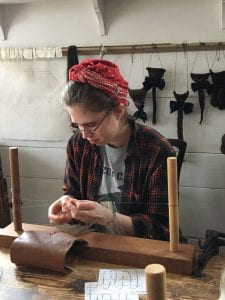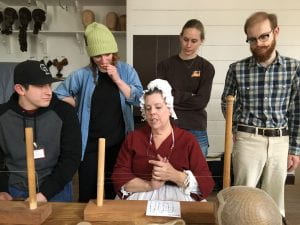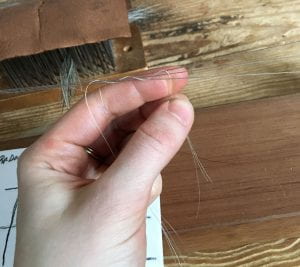A Craft in the Hands is Worth Two in a Book
By Eliza West, WPAMC Class of 2019
In the Colonial Williamsburg wigmaker’s shop, fast fingers fly, and strands of hair are artfully tangled between three taught threads. The master wigmaker reaches down with one hand to pinch off half a dozen hairs, then passes those strands over and under the threads six times, in a pattern which leaves them tightly locked into the weave, all the ends pointing in the same direction. To a casual observer, her hands move in a blur, and the manner in which the hairs are fixed in place could as easily be witchcraft as craftspersonship. Even when I watch with the sharp eyes of someone about to attempt this craft herself, the motion is too quick, and I find it almost impossible to follow.
The challenge of following this practiced motion with my eyes indicates to me that this is a skill which resides not in the mind, but in the hands. To learn it, not only will I need instruction from an expert, I will have to try it myself. If I master it, it will be through repetition, not theory. Luckily, the whole reason I’m in the wig shop is for a little hands-on learning. My classmates and I are on a trip for our course in pre-industrial craftspersonship. We’re in the middle of a busy three days, touring Colonial Williamsburg’s trades shops in order to try our hand at a whole range of 18th-century crafts. In the wig shop, we sit down at a row of hair weaving looms and begin trying to marry the instructions we’re given with the work of our own fumbling fingers.

After a few minutes of practice, I start to feel proficient at weaving hair, and my initial concentration melts into the focus needed for a careful but repetitive task. I’m still a ways off from being able to do this without thinking about it though!
Here is some of what we learn: you must only work with a few strands of hair at once. If it is coarse horsehair (for a frizzy-headed judge, barrister or preacher), you’ll want only a couple hairs. If instead, you’re working with finely-crimped yak hair, you can take up a few more strands, and perhaps as many as eight when you’re working with fine human hair to make a wig for a lady or a gentleman. Working with the cut ends of the hairs, you weave them in a complex M pattern, before sliding them firmly to the left, against the hair you have already woven. Each repetition makes up perhaps a sixteenth of an inch of this one weft – a single string of tied hair which will eventually become one of several wefts sewn down to a netted wig caul.
I find, as I try my hand at it, that this is an activity like knitting or riding a bike. It has a rhythm and a pattern which feels natural once you get yourself into the swing of it. At the same time, it is nearly impossible to put into words. This is a sensation I had many times during our Colonial Williamsburg trip. In the silversmith’s shop, Lynn Zelesnikar pushed a burin through copper as if it were completely effortless, her concentration on the design of the printing plate she was engraving, while the motion itself was clearly second-nature. In the blacksmith’s shop master smith Ken Schwarz swung his hammer with a precision which comes only from deeply ingrained patterns of work. At both the cooper’s and the wheelwright’s shops, craftspeople wielded drawknives as if they were extensions of their own arms.
The skill we learned in the wigmaker’s shop was perhaps easier that getting the knack of effectively pounding on hot iron. Nonetheless, it helped to reinforce an important lesson about preindustrial craftspersonship. Weaving hair demands that your hands know what they are doing. Without a teacher to apprentice under (even if only for an afternoon), a skill like this is hard to learn. While watching a master work can at first be overwhelming, once I was able to try my hand at each of these crafts, I found observing them to be essential, as I sought to emulate their patterns of work and efficient motions.
Watching master craftspeople carry out skilled and complex work without the assistance of modern machinery is a constant reminder of how the human body is able to develop amazing proficiency at a whole range of tasks we’ve virtually forgotten today. This is a valuable lesson, especially for academics, that what our hands know can be just as powerful and important as what our minds (or, for that matter, books) contain.





Leave a Reply